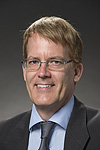Physics saves humanity
 |
|
Joe Lykken
|
"Later in life, I discovered I do love science, and I do love physics." —Anne Hathaway, The New York Times, Oct. 22, 2014
In the new movie "Interstellar," a brilliant theoretical physicist played by Jessica Chastain waits in a government laboratory, surrounded by cornfields, for the "quantum data" that will make sense of the tensor calculus equations scrawled on her blackboard. To me, this sounds like a typical day on the third floor of Wilson Hall, but the kicker here is that the quantum data reveals the secret of antigravity technology, allowing mankind to escape our dying planet. Physicists and engineers save humanity; roll credits.
A key scene of the movie has the budding scientist and her father (Matthew McConaughey — for the first time not shirtless in a movie) stumbling upon the laboratory complex, which is hidden deep underground. Their eyes widen in wonder as they are shown the futuristic facility, a humming beehive of the best and the brightest working together to accomplish a seemingly impossible mission.
This sounds familiar, too.
One of the best parts of my job is tagging along with the VIP tours of Fermilab, watching various important persons agog over our neutrino detectors and our superconducting RF cryomodules. The highlight of the Fermilab tour, as reported by the VIPs themselves, is when we give them the chance to chat with some of our "early-career researchers" (the politically correct term for young scientists). Excitement and vision are contagious, even to those for whom the underlying science and technology seem as distant as McConaughey's spacecraft.
I do have one major complaint about the "Interstellar" version of a national laboratory, namely its depiction as secret and isolated. Although the stated reason for the secrecy is intriguing (avoiding Congressional oversight), this is the last thing you want if your mission is to save the world.
At Fermilab, our connections to universities, to other national labs, and to international partners such as CERN, are a huge amplifier of our science and of the technology innovation that enables it. More than anything else, our open collaborative culture empowers our success. If your lab feels like a lonely satellite in a rogue orbit, you're in trouble. If it feels like Grand Central Space Station, then most likely great things are happening.
|